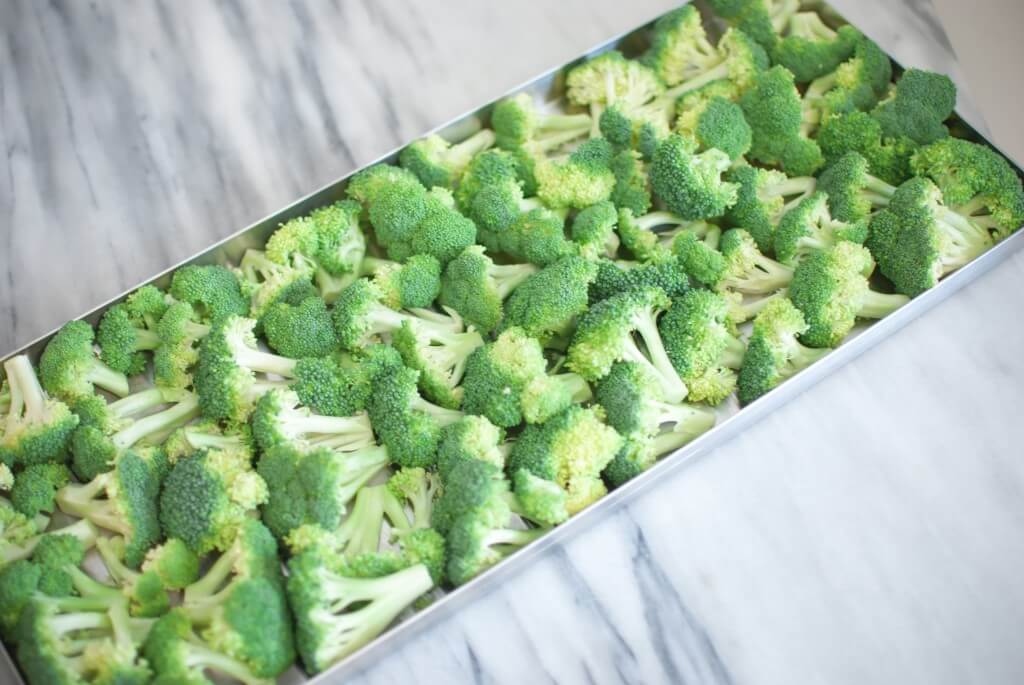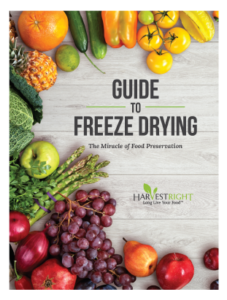It’s the end of the final harvest time for many gardeners around the country. Cooling temperatures and more rain give vegetable plants a boost, so you’re likely to end up with more than you can handle. Traditionally, gardeners would either can or freeze their surplus for use in winter. However, those two methods tend to do strange things to vegetables. Frozen vegetables are easily freezer burned, and both frozen and canned vegetables lose their crunch when subjected to boiling water or canning.
If you have a Harvest Right home freeze dryer, the days of making do with soggy vegetables in winter are over. You can freeze dry vegetables whether they are raw or cooked. If you plan to rehydrate your vegetables, we’ve found that blanching them beforehand will help bring them back to that perfect texture. But, either way, simply spread your vegetables such as broccoli, green beans or Brussels sprout on the freeze drying trays and run them through a standard cycle. When the process is complete, store them in air tight containers or Mylar bags with an oxygen absorber so they don’t absorb moisture from the air.
When you’re ready to use them, rehydrate them with hot water or toss them right into your favorite soup recipe as you’re making it on the stove. Your rehydrated freeze-dried vegetables can retain so much freshness that they’ll even stand up to your favorite summer salad recipes weeks or months after they came out of the garden. Or, if you’re just in the mood for a healthy substitute for chips, spritz your veggies with a bit of olive oil and your favorite seasoning and you’ll be so glad you skipped the can of Pringles.







*When I originally commented I clicked the -Notify me when new comments are added- checkbox and now each time a comment is added I get four emails with the same comment. Is there any way you can remove me from that service? Thanks!
We are trying to do that. So weird. And, so sorry.
I have found the best method of seasoning is a light dusting of Onion Granules (NOT Power) and Garlic Granules. I do not use any Oil of any kind as oil does not freeze dry and i want the longest storage time as possible. I cut the Beans in short segments, about 1 inch, to open up the ends to make a shorter dry time; same with Carrots, slice them in coins for more surface area. I steam in a shallow pan to retain more nutrients with the seasoning. Best of Luck. Love my HR now that i have the no-oil pump.
What are onion and garlic granules? Where do you get them? Thank you.
Most “powders” are actually granules. I found onion powder and it is so much finer than what I had been buying as powder.
Should I season the raw veggies (they would be tossed in oil first) or is it better to season after rehydration?
I do a quick blanch (maybe like 2 minutes), then toss with a little olive oil and sprinkle salt, then freeze dry. That’s what has worked for me for zucchini and squash when I am making veggie chips.
Adding any oils to any foods will lessen the shelf life of your product as the oil gets rancid. Best to do it with no oil.
I believe they mean to spritz with oil and season AFTER the veggies have been freeze dried.
How do you freeze dry cabbage.
Some customers shred the cabbage, dip in boiling water for 2-3 minutes, then in cold water, then freeze dry. It freeze dries perfectly. However, blanching is not a requirement, as many people have found no difference between blanched and non-blanched before freeze drying. Think frozen, as far as the rehydrated texture goes, but, is nice for soups, coleslaw, egg rolls, sauerkraut, etc., so many uses. It’s good just to munch on crunchy, too.
I just shred mine or chop and throw on freeze dryer trays after washing. Already to add to a soup or cook as is. I’ve even taken a bag of Cole slaw mix and freeze dried that so it wouldn’t spoil. I will use it in a soup.
You can even still use it to make cole slaw.
I want to make vegetable and fruit powders so would it work to freeze dry them raw or do I need to blanch them first? I’m thinking that I could powder them in my Vitamix. Any comments, recommendations or thoughts? Thanks!
You can freeze dry them raw and then powder. This works great.
I’ve been buying organic citrus, so I can use the skins, all kinds, slicing thin, freeze drying and powdering in the blender. Then I use them in my herbal tea mix. It makes a beautiful powder, especially the pink grapefruit! 😁 And the peel has so much nutrition!
Can I freeze dry chard without blanching first?
I’ve freeze-dried lots of chard and kale without blanching. Reconstitutes great in soups, stews, stir fries, etc. I wash it and finely dice then freeze dry. So nice having it on hand all winter to throw in things!
How long does it take to freeze dry chard?
My swiss chard freeze dries in under 24 hours from pre frozen state. I do a quick steam before hand, then prefreeze.
What is the texture of veggies & fruits when you reconstitute them? Are string beans and blueberries (for example) mushy when reconstituted or firm like before they are freeze dried?
Can you freeze dry green beans and still taste good or blanch them first?
I like to freeze dry them raw since I will have a heavy crop coming.
I appreciate any reply. I have ordered a large unit which is on the waiting list. I have the middle size for over 4 years doing the work now.
I love your company but also love the support team.
I know that the blueberries once FD are nice and crunchy but once you add water, they are very soft and juicy.
Can I freeze dry rutabaga? Shouldn’t be blanched first? Thanks!
I have rutabaga slices and beet slices in my freeze dryer right now. I did not blanche them. I want to eat them as chips but maybe use them for cooked also. I think they will be fine without blanching. Not 100 % sure though. I didn’t blanche the beets either. Gonna make powder with those to fill capsules. I have had freeze dried rutabaga before and it wasn’t blanched.
Can you freeze dry more than one kind of veggie at the same time. green beans and carrots for instance
Yes, I do it all the time
I have green beans, chicken, ham, and tomato in the FD right now
Can you freeze dry bean sprouts?
Instead of blanching, can I cook with with soy sauce and spices?
Blanching vs. Raw
Is there a list of veggies that shows whether or not blanching is important?
THANKS in advance!
I would be interested in this as well.
I have a ton of frozen veggies that I need to freeze dry. Is there a setting on the Harvest Right for things that are already frozen to maybe skip that step. I can’t find anything about it.
If you have a freeze dryer that is new within the last year it will automatically sense if the food is pre-frozen and know what to do.
Should my freeze dried broccoli stems turn brown after putting in the jars with oxygen absorber? The crown is nice and green.
To maintain better color for long term it is best to package in a mylar bag with an oxygen absober. Light can degrade the color.
I would blanch them a little longer so the stems get blanched more.
I am new to freeze drying. I have an older freeze dryer, is there a way to adjust settings if I prefreeze food?
I had 2 cans of dole pineapple juice-ready for expiry. I tested them, then powdered it.
Best pineapple ice cream and or cheese cake ever!!
Is it best to blanch sweet corn or leave it raw before freeze drying?
It is best to blanch. This will keep the color and flavor better long term.
Can I freeze dry red kidney beans or pinto etc or do I need to cook them first?
I would cook hard beans first. I’ve done this and they rehydrate nicely.
I would cook hard beans first. Make sure not to eat red kidney beans raw.